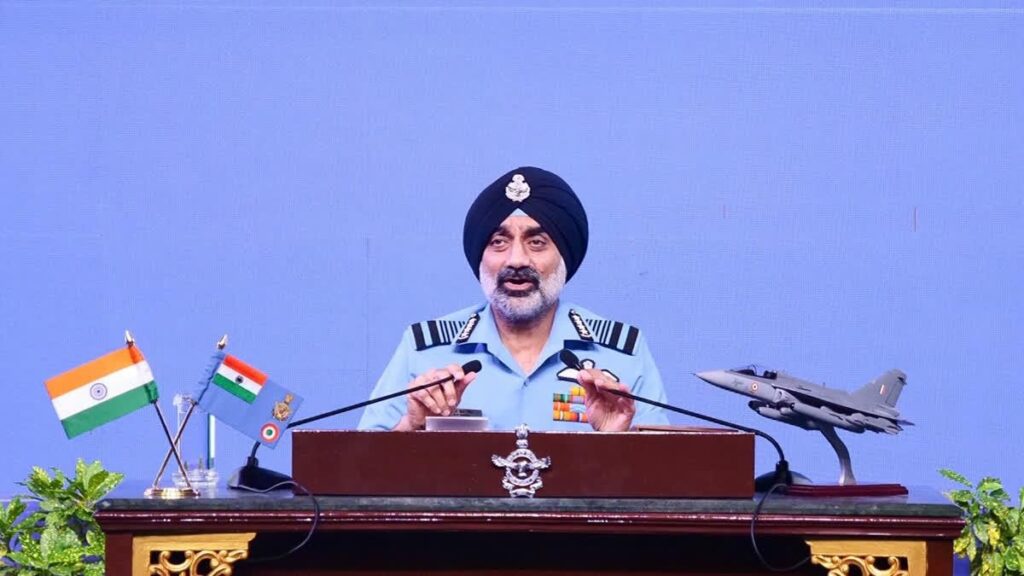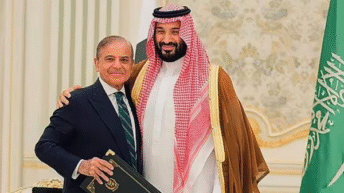
On the eve of the Indian Air Force’s 93rd anniversary, the Chief of Air Staff, Air Chief Marshal AP Singh, addressed the media, reflecting on a year of intense operational activity, humanitarian engagement, capability development, and long-term planning. Speaking with pride and a clear sense of purpose, he described the past year as one in which the IAF not only demonstrated its combat capability but also deepened its joint operating concepts and renewed its commitment to indigenisation and future preparedness.
The Air Chief started by framing Air Force Day as a time for reflection and appreciation. It is “an opportunity to think about what has been done in the last one year,” he said, and to “celebrate from where we have started to which place we have reached.” He paid tribute to predecessors and veterans whose leadership has shaped the current IAF, and reminded everyone that the anniversary is both a celebration and a moment for introspection – a time to evaluate performance, learn lessons, and look ahead.
Operation Sindoor
At the heart of the briefing was a detailed account of the IAF’s role in Operation Sindoor, which the Air Chief described as the defining operational moment of the year and an example of how calibrated airpower, integrated defences, and joint planning can achieve political and military objectives swiftly. He emphasised that the nation set a clear objective — to make those responsible pay the price for the killings in Pahalgam — and that the IAF was the principal stakeholder tasked with striking two major targets among nine planned. What followed, he said, was a brief, intense conflict spanning four days that exemplified “a war started with a very clear objective and terminated quickly without prolonging it.”
Contrasting Sindoor with ongoing conflicts elsewhere, the Air Chief stated that India had effectively used measured, precise military actions to weaken enemy capabilities and encourage the opponent to seek a halt to hostilities. He emphasised that the combined use of offensive strikes and a strong, integrated air defence system prevented escalation and achieved the desired end state of the campaign.
Integrated Air Defence as A Game-Changer
A central theme of the briefing was the vital role of integrated air defence in the overall campaign. The IAF’s air defence assets, counter-UAV measures, and the Integrated Air Command and Control System (IACCS) — coordinated with Army and Navy systems – operated under a single, synchronised control. The Air Chief described this integration as a “game-changer,” preventing the enemy from freely operating and enabling “deep looks” into enemy territory. He highlighted the impact of recently acquired and operational long-range surface-to-air missiles, crediting them with a significant increase in reach and with “the longest kill” recorded at over 300 kilometres – a capability that “seriously curtailed” enemy activity. The offensive aspect of the campaign, he noted, depended heavily on indigenously developed and integrated munitions, allowing precise strikes deep inside hostile territory (beyond 200 km), across a 1,200-kilometre front, with minimal collateral damage. The Chief described Sindoor as a rare display of concentrated air power – “catastrophic firepower” delivered by the Air Force for the first time since 1971.
Jointmanship and Three-Service Planning
The Air Chief emphasised that Sindoor was not a unilateral air campaign. It was a joint effort in planning and implementation, involving Army and Navy resources, DRDO contributions, and DPSU support. He stated that this formalised cooperation was the first of its kind at that level and was key to achieving a successful outcome. He advocated for institutionalised integration rather than ad-hoc measures — supporting the creation of formal structures that document the lessons of Sindoor for planning and executing future operations more effectively.
The Changing Fog of War – Media’s Role
On information and perception management, the Air Chief reflected on the transformed nature of the ‘fog of war’. Today’s fog, he said, is often caused by the rapid spread of misinformation and fake news. He commended the Indian media for working closely with the armed forces during the conflict — “soldier to soldier” – helping to correct false narratives and boost national morale. He stated that responsible media reporting has been vital in preventing negative impacts on troops and the public, and he thanked journalists for being “in sync” with the armed forces.
Humanitarian Assistance and Disaster Relief (HADR)
Beyond kinetic operations, the Air Chief highlighted the IAF’s ongoing role as a first responder to natural disasters and emergencies. Over the past year, the IAF contributed to relief and rescue efforts across India — including Bihar, Tamil Nadu, Assam, Jammu & Kashmir, and other regions — responding to coal-mine collapses, tunnel rescues, avalanches, landslides, and floods. The IAF’s aircraft, Garud commandos, and aircrew supported multiple missions, often collaborating with Army, Navy, and NDRF teams to evacuate civilians, airlift supplies, and deliver equipment and rescue personnel. Emphasising international evacuations, he stated that the IAF airlifted nationals from crisis zones such as Myanmar, Laos, Vietnam, and Kenya.
Exercising with Partners
The Air Chief reviewed a busy schedule of bilateral and multilateral exercises as a vital means to strengthen interoperability, exchange operational philosophies, and build rapport. He listed engagements with nations including the UAE, Egypt, Greece, France, and Singapore, and said senior foreign chiefs had praised the professionalism of Indian teams. Such exercises, he added, sharpen tactics, expose the force to varied operating concepts, and expand India’s defence diplomacy footprint.
Space and Human Spaceflight
A notable non-combat achievement was the IAF’s involvement in human spaceflight. The Chief celebrated the flight of Group Captain Shubhanshu Shukla aboard an AXIOM Mission 4 and recalled earlier Air Force astronaut Rakesh Sharma. He stated that the IAF had played a significant role in selecting, training, and designing curricula for a group of astronauts, as well as supporting capsule development—demonstrating the Service’s growing role in national space efforts.
Vision 2047 – Roadmap for an Aerospace Power
Looking ahead, the Air Chief described the Service’s transformation as a long-term initiative. He unveiled a roadmap to 2047 – a strategic plan aimed at developing a multi-domain aerospace capability capable of safeguarding national interests across various conflict scenarios. The Chief recognised that such long-term planning cannot be “cast in stone” due to rapid technological advances; therefore, the roadmap will be reviewed periodically and adjusted as necessary. Key elements of Vision 2047 include the enhancement of indigenous platforms and systems: LCA Mark-2, AMCA, utility helicopters, medium transport aircraft designs, advanced weapon variants (including Akash and the next-generation Akash), Project Kusha for long-range surface-to-air capability, BrahMos family systems, smart anti-airfield weapons, AWACS, and modern radars. The Chief also highlighted strategic partnerships as a practical approach for swiftly filling critical capability gaps and integrating technology into domestic industry.
The Chief emphasised the Government’s initiatives to support small industry, MSMEs, and startups, and described the Air Force’s Directorate of Aerospace Design as a “DAD”-like supporter for indigenous players – guiding them through development cycles and aiding technology absorption. He highlighted the importance of balancing immediate operational needs with long-term indigenous development and leveraging strategic partnerships to speed up capability transfer when needed.
Regarding the institutionalisation of the integration that Sindoor demonstrated, he stated that the IAF, together with the Army, Navy, and DRDO, is working to formalise structures that underpin joint operations and shared command and control. The Chief argued that if future warfare is to be won, formal joint structures must be developed based on lessons learned domestically, rather than simply adopting foreign models. The aim is to create joint mechanisms that are superior to current ones, not just marginal adjustments.
The media question session covered topics ranging from platform timelines to theatre commands. On the Advanced Medium Combat Aircraft (AMCA), the Chief deferred technical specifics to the Aeronautical Development Agency (ADA) and DRDO but indicated confidence that first flight targets remain in the latter half of the decade, with possible induction in the 2030s if timelines hold. Regarding offers such as the Su-57, the Chief reiterated that the Defence Ministry and IAF follow a rigorous, requirement-based induction process; any acquisition would be evaluated on how well it meets India’s needs, transfer-of-technology and “Make in India” terms.
On Pakistani losses during Sindoor, the Chief outlined the assessed damage to enemy assets: multiple radars destroyed, command and control centres hit, runway damaged, hangars damaged with evidence of one C-130 class transport, an AWACS or SIGINT platform, and several fighter aircraft – assessments drawn from post-strike intelligence and debriefs. He also noted intercepts and long-range engagements that had neutralised airborne high-value platforms along with five fighters. Regarding Pakistan’s claims of shooting down IAF aircraft, the Air Chief dismissed them as imaginative stories and added that they should let the enemy account for 15 aircraft lost by India when planning their next move. “I hope they are convinced about it and they will consider 15 fewer aircraft in my inventory when they come to fight again. So why should I talk about it?”
Regarding future airpower and unmanned systems, he argued that manned platforms will remain relevant for at least the next decade. Unmanned systems and automation will expand and must operate alongside manned aircraft; they will not fully replace pilots. Programs such as DRDO’s Ghatak and UKAP reflect that commitment to combat-capable unmanned platforms as an essential part of future force structure.
Regarding fleet modernisation, he stated that the Su-30 upgrades are progressing with phased integration and potential collaboration where necessary; he observed that upgrade numbers are often limited by platform life cycles. Concerning the LCA Tejas Mark-1A, he emphasised that the IAF’s expectations are based on established QRs and certification standards; once those criteria are met, the service is eager to accept the aircraft. He explained that the LCA Mark-2 is a natural evolutionary step — a larger class with increased payload and endurance — and could follow as production and timelines allow.
Addressing concerns over delayed basic trainer aircraft caused by supply chain issues, the Chief acknowledged the shortfalls and described adaptive measures the IAF has implemented to sustain pilot throughput. He emphasised the urgent need to replace ageing Kiran trainers and expressed hope that supply chain bottlenecks will soon be resolved.
Conclusion
He concluded by assuring citizens of the IAF’s ongoing commitment: “We have to be, you know, a citizen first, a nationalist first and thereafter be an air warrior.” The Service will continue to modernise, integrate, and nurture indigenous capabilities while remaining prepared to respond to both crises and humanitarian needs. At the same time, he warned the media and the public about operational security, urging responsible reporting and caution to avoid providing adversaries with actionable details.






Add comment